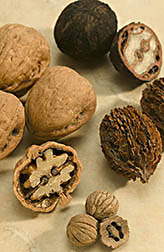This page has been archived and is being provided for reference purposes only. The page is no longer being updated, and therefore, links on the page may be invalid.
Read the magazine story to find out more. |
|
World's Walnuts Flourish in California Research Orchard
By Marcia WoodAugust 5, 2005
Crunchy, good-for-you walnuts sold in supermarkets across America are typically the English or Persian kind, known to scientists as Juglans regia. This popular nut likely originated from Persia. It's thought to have taken on the "English walnut" moniker when, centuries ago, British trading ships brought it to ports around the globe.
This familiar walnut belongs to a family of more than a dozen other species. Many of them are flourishing in a unique research orchard in northern California, managed by scientists with the Agricultural Research Service (ARS). With species from both the Old and New World, it's the largest, most genetically diverse walnut collection anywhere, according to ARS research horticulturist and curator Ed W. Stover at Davis, Calif.
Headquartered in Davis, the collection is part of what's officially known as the ARS National Clonal Germplasm Repository for Tree Fruit and Nut Crops and Grapes. ARS manages a nationwide network of such genebanks. These valuable genetic collections help prevent the rich genetic diversity, or gene pool, within crop plants and their rare, wild and unusual relatives from being lost forever to insects, diseases or urban sprawl.
Among the collection's most unusual walnuts are some J. regia trees from Armenia. Oddly, their shells are somewhat larger than a golf ball, but the nut meats inside are only of average size.
Researchers, breeders and plant nursery managers can use this remarkable genebank, according to Stover. Here's an example: Several years ago, ARS research geneticist Mallikarjuna K. Aradhya, based at Davis, and his University of California at Davis co-investigators developed a set of what are known as walnut microsatellite markers.
Based on a tree's distinctive genetic material, or DNA, markers help breeders and others quickly and accurately "fingerprint" individual J. regia trees, for instance. That, in turn, helps avoid costly mixups about "who's who" among walnut trees in nurseries, orchards or backyard gardens.
Read more about the research in the August 2005 issue of Agricultural Research magazine.
ARS is the U.S. Department of Agriculture's chief in-house scientific research agency.

